In recent years, rustic garage design has evolved beyond basic storage, blending reclaimed materials and modern functionality to craft warm, inviting spaces. Barn wood accent walls are paired with matte epoxy floors for durability, while sliding barn doors and industrial lighting bring character and practical illumination. From open iron shelving to chalkboard organization walls, these trends offer both aesthetic appeal and efficient storage solutions. Whether you’re transforming your garage into a workshop or a hobby lounge, embracing these rustic elements can elevate the space’s charm and utility. Let’s explore twenty inspired ideas for creating a rustic garage that balances timeless style with everyday practicality.
1. Rustic Garage Accent Wall with Reclaimed Barn Wood
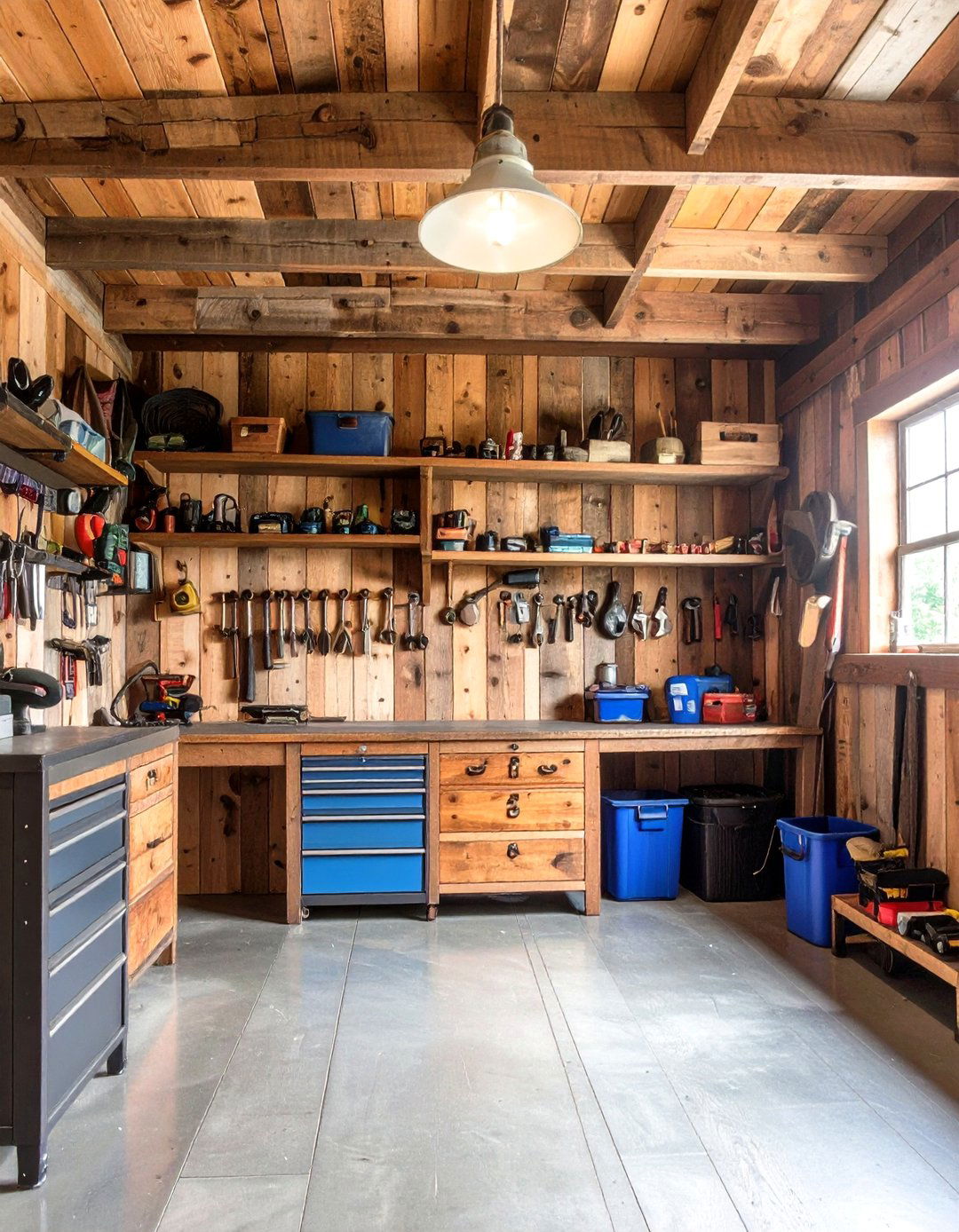
A reclaimed barn wood accent wall can instantly infuse a rustic garage with history and character. Begin by sourcing weathered planks from local salvage yards or reclaimed barn suppliers, ensuring a variety of tones and textures. Install the wood horizontally or in a herringbone pattern for visual interest, securing each plank with rust-proof nails. Seal the wood with a matte polyurethane to protect against moisture without sacrificing its natural patina. This accent wall not only anchors the space but also provides a warm backdrop for tools, shelving, or artwork. By highlighting the unique knots and grain of the wood, you’ll create a rustic garage feature that feels both inviting and authentic.
2. Sliding Barn Door for Rustic Garage Entry
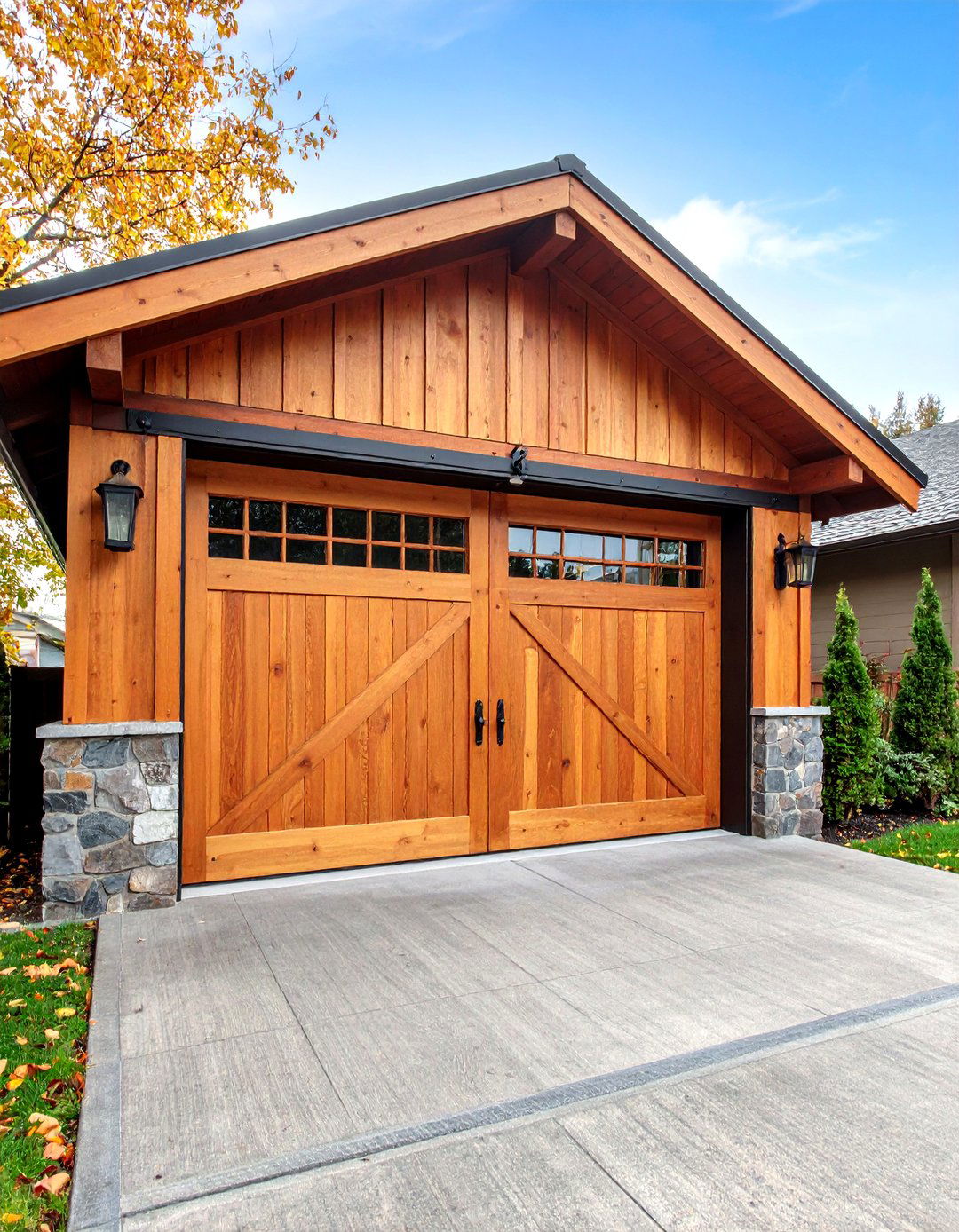
A sliding barn door brings authentic farmhouse charm to a rustic garage while maximizing functional space. Install a heavy-duty steel track above the entrance, ensuring it’s level and securely anchored into studs. Choose a door crafted from reclaimed wood or distressed planks, pairing it with decorative wrought-iron hardware for an industrial twist. To protect floors from abrasion, add a floor guide at the base that matches the door’s finish. This design not only elevates curb appeal but also enhances accessibility by allowing the door to glide smoothly in tight quarters. This approach aligns with the top garage door design trends for 2025, where homeowners favor bold, customizable finishes to express personal style.
3. Exposed Ceiling Beams in Your Rustic Garage Workshop
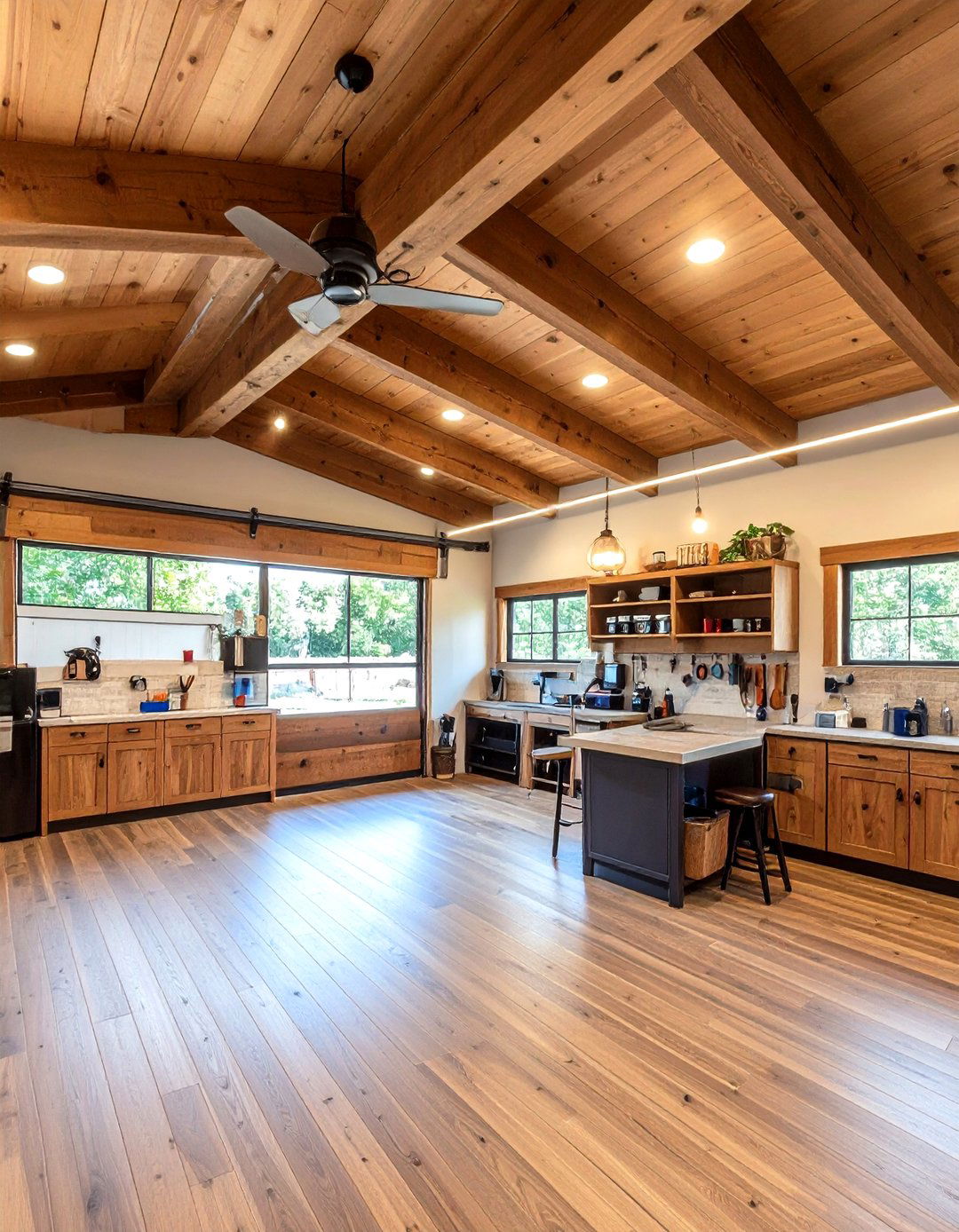
Exposing ceiling beams transforms a standard roof into a dramatic focal point in a rustic garage workshop. Remove any drop-ceiling tiles or drywall to reveal the structural joists, then sand and stain the beams with a warm walnut finish to highlight the wood’s natural grain. If structural timbers aren’t part of your current garage, consider installing faux beams made from reclaimed wood for the same visual impact without the heavy lifting. Once in place, affix LED strip lighting along the underside of each beam to provide ambient illumination. This approach not only showcases architectural elements but also creates a cozy atmosphere that makes long workshop sessions more enjoyable.
4. Matte Epoxy Floors for Durable Rustic Garage Foundation
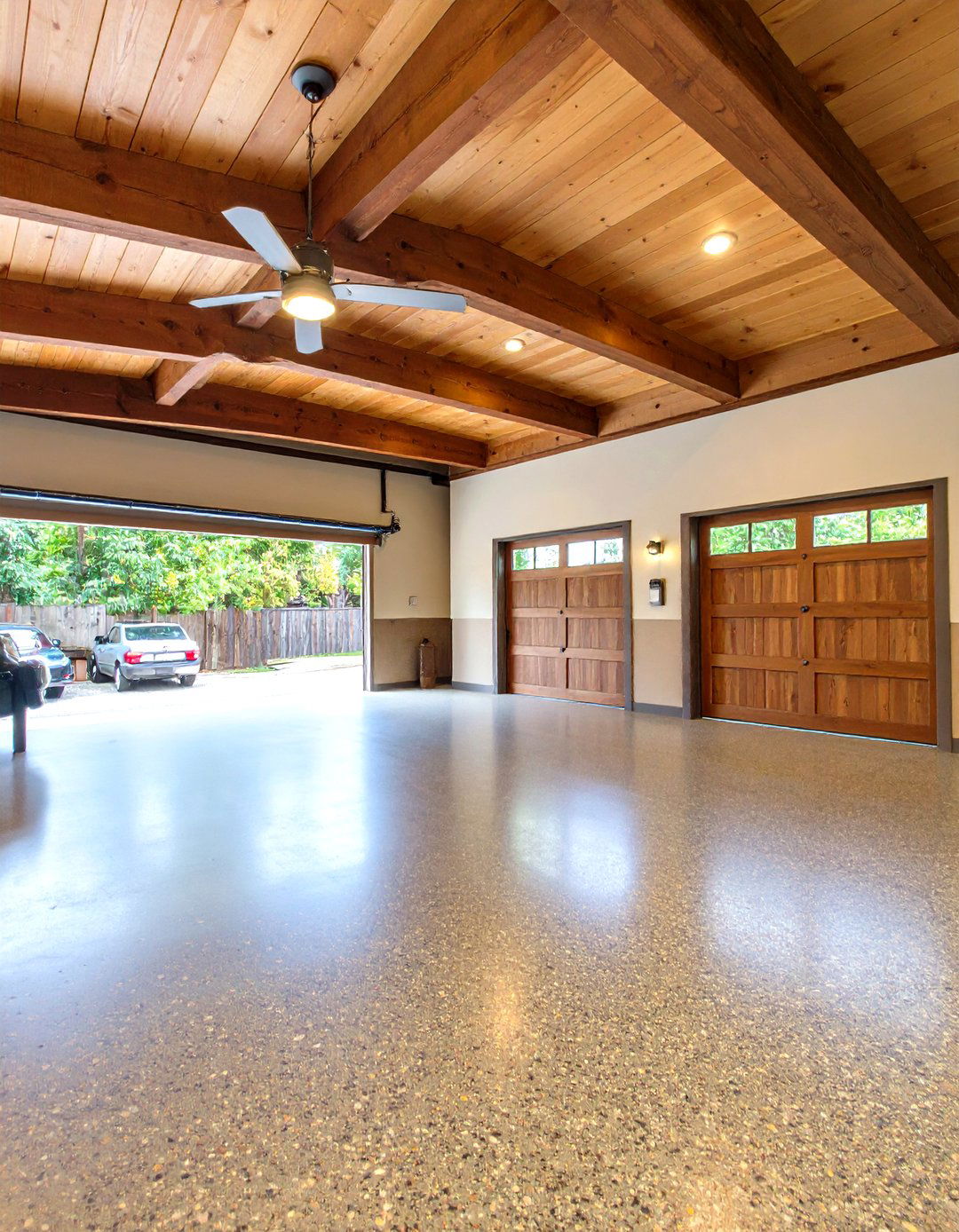
Matte epoxy floor coatings offer a low-maintenance foundation that complements rustic garage aesthetics. Before application, thoroughly clean and etch the concrete substrate, then apply a primer layer to ensure optimal adhesion. Choose a muted, earth-toned epoxy blend with subtle metallic flakes for a handcrafted look that conceals light scuffs and imperfections. The matte finish minimizes glare under task lighting, while the epoxy’s chemical resistance safeguards against oil spills and stains. To enhance slip resistance, broadcast fine quartz aggregate during the final coat application. Once cured, your floor will showcase the ideal balance of rugged durability and understated style, making it a practical choice for heavy-duty garage use.
5. Industrial-Style Pendant Lighting in a Rustic Garage

Industrial pendant fixtures can transform a rustic garage into a well-lit, inspirational workspace. Select metal shades in aged brass or black iron finishes, paired with vintage-inspired Edison bulbs for warm illumination. Position the pendants above workbenches, the center of the bay, or along a tool wall to ensure balanced light distribution. To simplify wiring, mount a ceiling-mounted track that allows the fixtures to be relocated as your garage layout evolves. For a cohesive look, match the pendant’s metal finish to cabinet hardware or door tracks. This lighting choice not only highlights rustic wood and metal textures but also creates a focused atmosphere perfect for detailed tasks.
6. Custom Workbench from Salvaged Wood in Rustic Garage
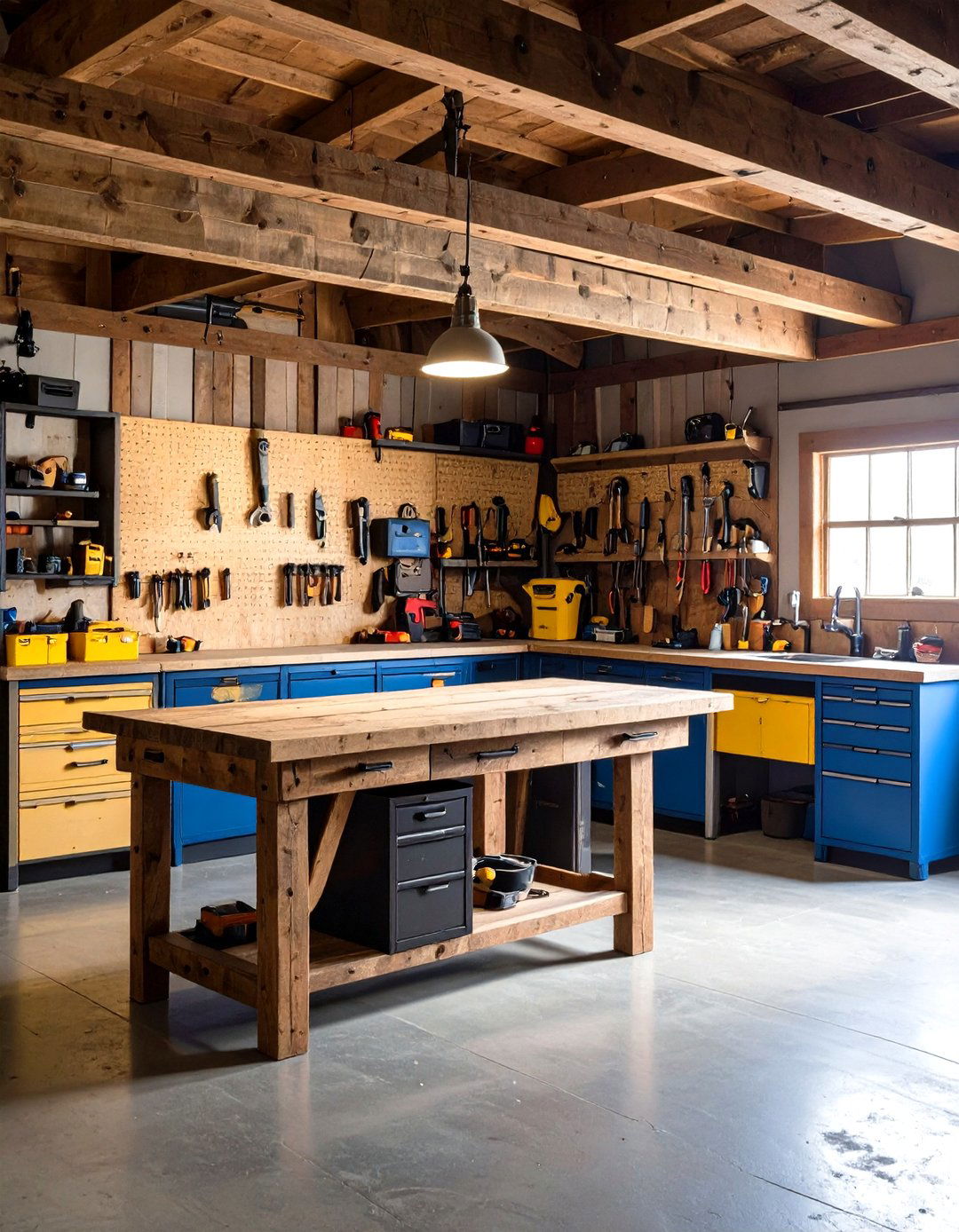
A durable workbench crafted from salvaged wood brings both utility and rustic appeal to any garage workshop. Source sturdy hardwood beams or reclaimed lumber, cutting and planing the boards to a uniform thickness. Assemble the frame using pocket-hole joinery for strength, then finish the surface with a food-safe mineral oil to protect against stains and moisture. Incorporate built-in drawers or pegboard panels beneath the top to keep tools organized and within reach. Anchoring the workbench to the wall or floor enhances stability during heavy-duty use. This handcrafted piece not only serves as a functional workspace but also becomes a focal point that celebrates sustainable materials in your rustic garage.
7. Open Shelving with Iron Brackets in a Rustic Garage

Open shelving supported by iron brackets is a versatile storage solution that reinforces rustic garage style. Use thick wooden planks, such as oak or pine, and finish them with a clear matte sealant to protect against humidity. Pair each shelf with black iron L-brackets featuring decorative scrollwork, securing them into wall studs for maximum load capacity. Arrange the shelving at varying heights to accommodate items like toolboxes, paint cans, and decorative crates. Label each section with chalkboard tags for quick identification. This open-concept approach keeps frequently used items visible and accessible, while the combination of wood and metal enhances the rugged charm of a rustic garage.
8. Corrugated Metal Accents on Rustic Garage Walls
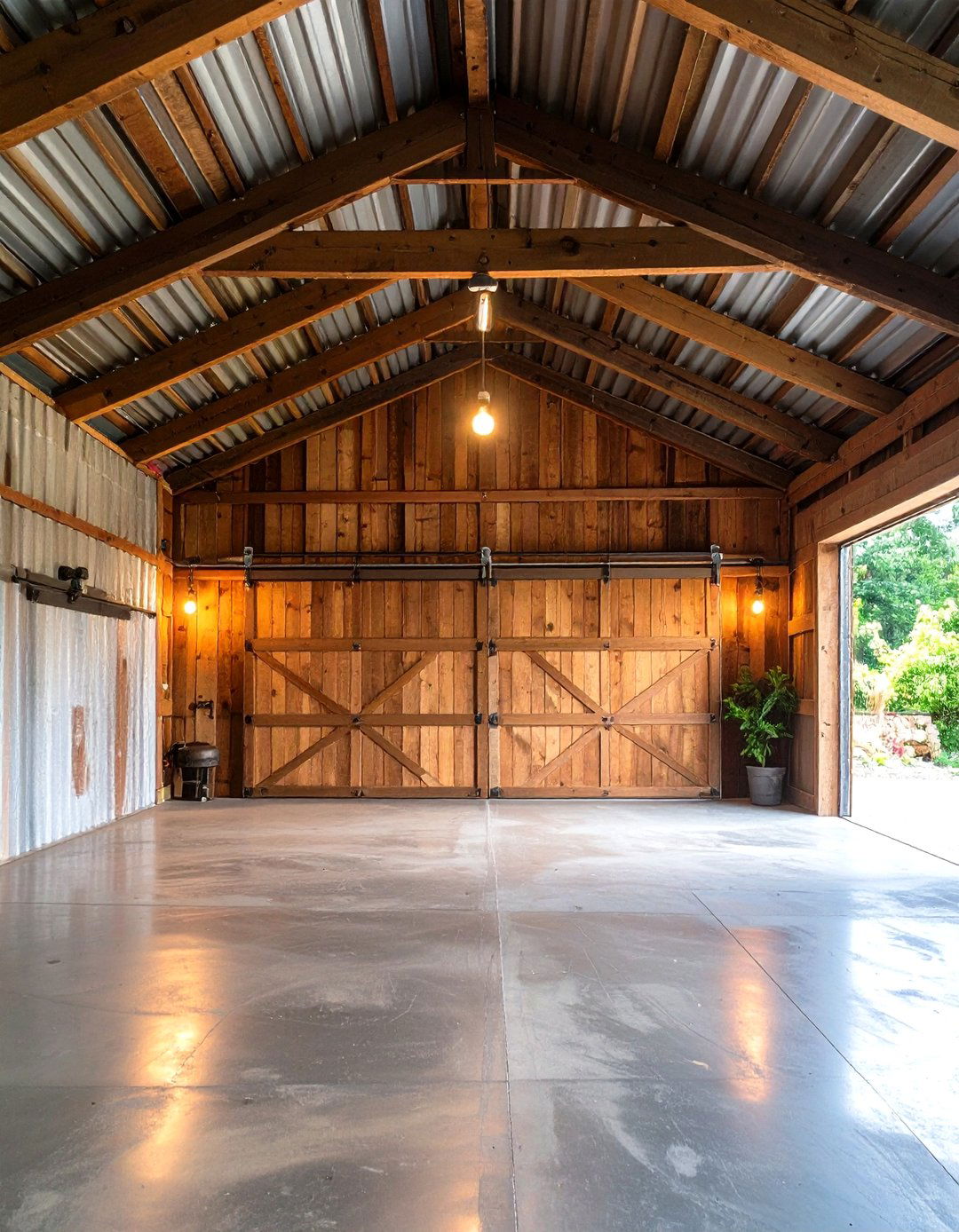
Corrugated metal panels add texture and an industrial edge to a rustic garage design. Select weathered or galvanized steel sheets and mount them on a wooden subframe attached to studs. Overlap each panel slightly to create a waterproof barrier and ensure a seamless look. For a cohesive finish, pair the metal with natural wood trim around doorways and windows. The reflective surface brightens the space by bouncing light from garage doors and overhead fixtures. To soften the industrial feel, introduce greenery in hanging planters or lean a reclaimed ladder against one wall. This blend of raw metal and organic elements defines the modern rustic garage aesthetic.
9. Chalkboard Wall for Organization in Rustic Garage

A chalkboard wall turns an unused section of your rustic garage into an interactive planning station. Paint a smooth plywood panel or drywall with chalkboard paint, applying two to three coats for even coverage. Mount the panel vertically at eye level near your workbench or entry door. Use chalk to jot down project to-dos, tool inventories, and measurement notes, erasing and updating the board as tasks evolve. Install a small shelf or magnetic strip beneath the chalkboard to store chalk sticks, erasers, and rulers. This tactile feature encourages collaboration and ensures you never lose track of essential details in your rustic garage projects.
10. Vintage Signage Display in a Rustic Garage Lounge
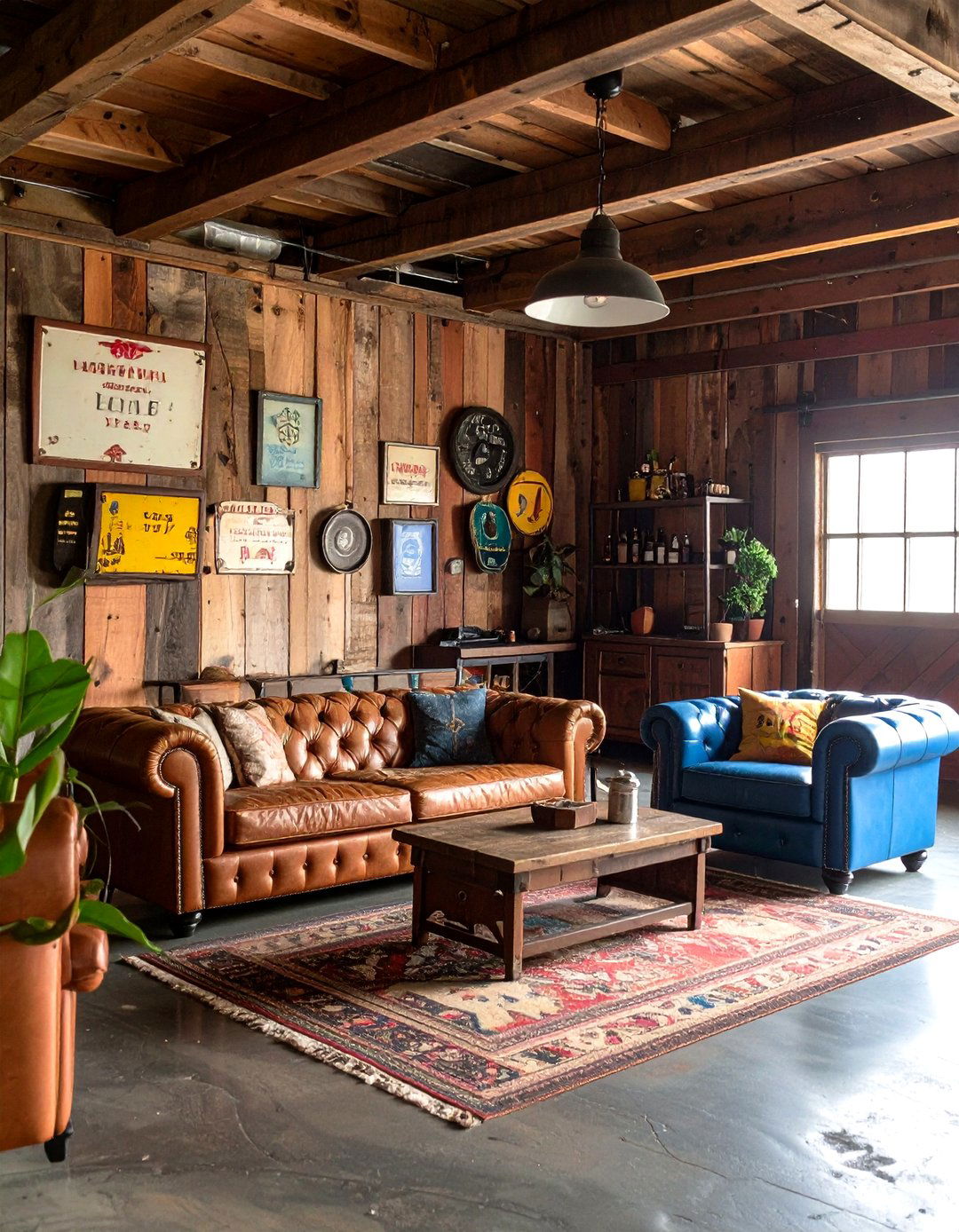
A lounge area in your rustic garage becomes more authentic when adorned with vintage signage. Hunt for old enamel or tin signs at flea markets, salvage yards, and online auctions, focusing on automotive, oil, or hardware branding. Secure the signs directly onto reclaimed wood paneling using wire hangers or stud-mounted hooks. Arrange the collection at varying angles and heights to mimic a curated gallery wall. Accent the display with a comfortable leather sofa or swivel chairs in distressed finishes. This nostalgic touch not only sparks conversation but also reflects the heritage of machinery and craftsmanship that defines a timeless rustic garage environment.
11. Leather Lounge Chair for Comfort in Rustic Garage
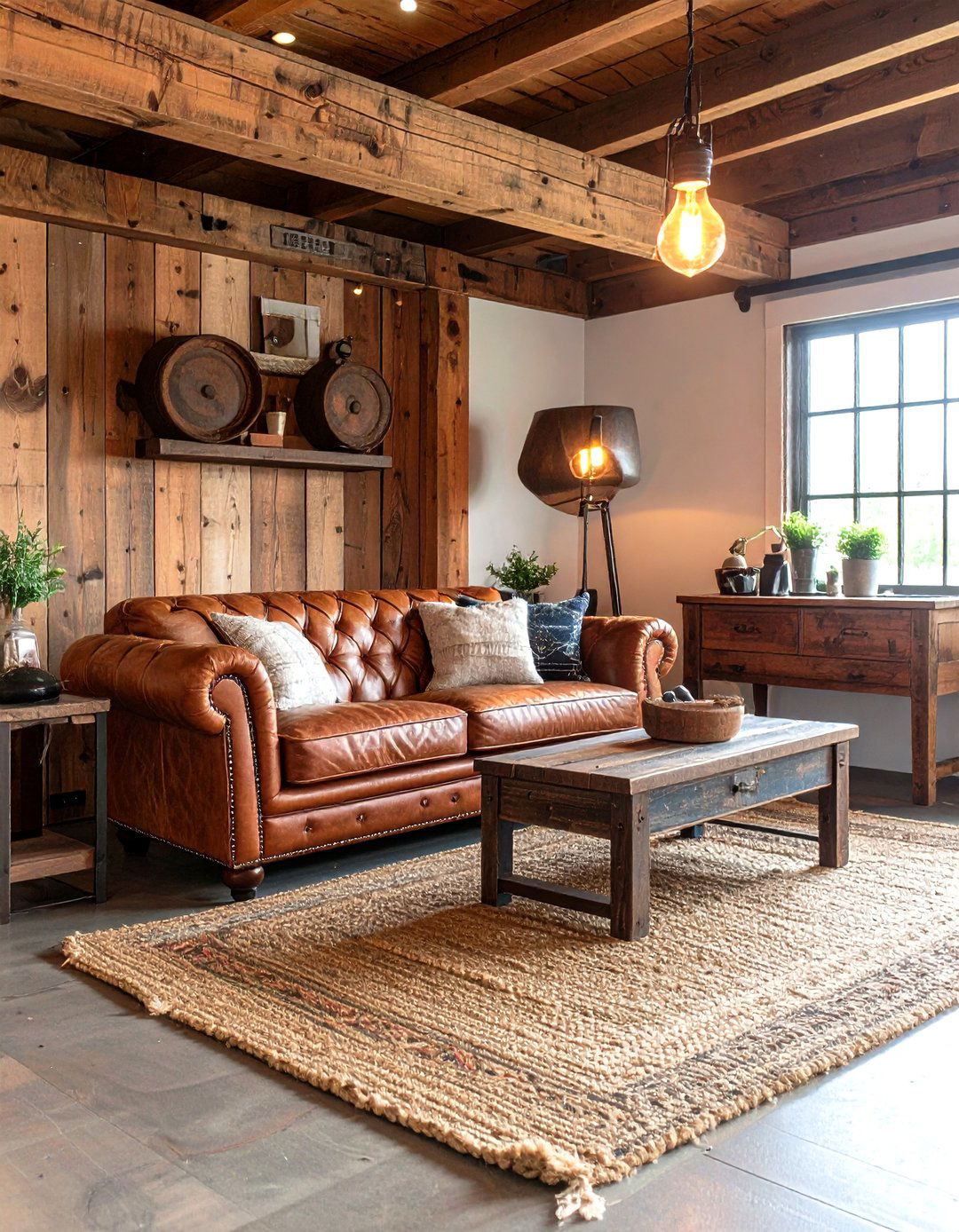
A cozy leather lounge chair provides a comfortable retreat in a rustic garage lounge zone. Choose a chair upholstered in full-grain or top-grain leather with a vintage patina to complement raw wood and metal accents. Position it next to a small side table made from reclaimed wood, adding a warm Edison bulb floor lamp for reading or relaxing between projects. To protect the concrete floor, place a natural jute rug beneath the seating area, anchoring the space visually. Selecting leather upholstery in warm taupe or brown wood-inspired hues echoes recommended garage accent colors for timeless curb appeal. This seating vignette not only offers a rest spot but also elevates the garage’s function as a versatile social hub for brainstorming, casual meetings, or downtime.
12. Galvanized Storage Bins for Rustic Garage Organization
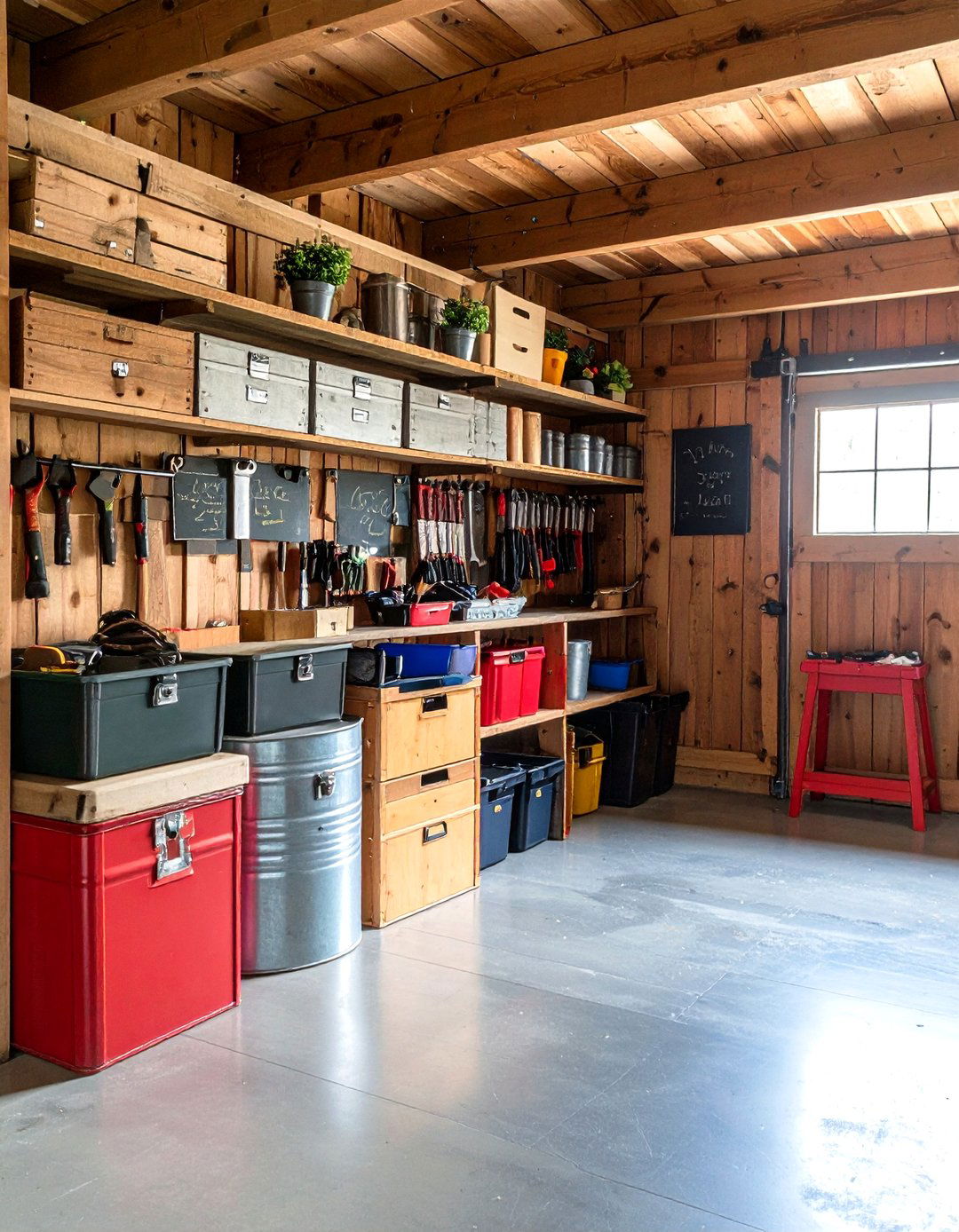
Galvanized steel bins deliver rugged, moisture-resistant storage in a rustic garage. Mount a row of shallow bins on a wooden plank affixed to the wall using hook brackets, ensuring each bin is easily slid out when needed. Label them with chalkboard-painted tags or metal plate engravings to identify contents like nails, screws, or small parts. The bins’ industrial finish harmonizes with wood beams and iron accents, while their durability stands up to heavy use. For larger items, stack matching bins on open shelving or repurpose a vintage locker system. This system keeps the work area clutter-free and enhances organizational efficiency in your rustic garage.
13. Stone Accent Corner for Textural Contrast in Rustic Garage
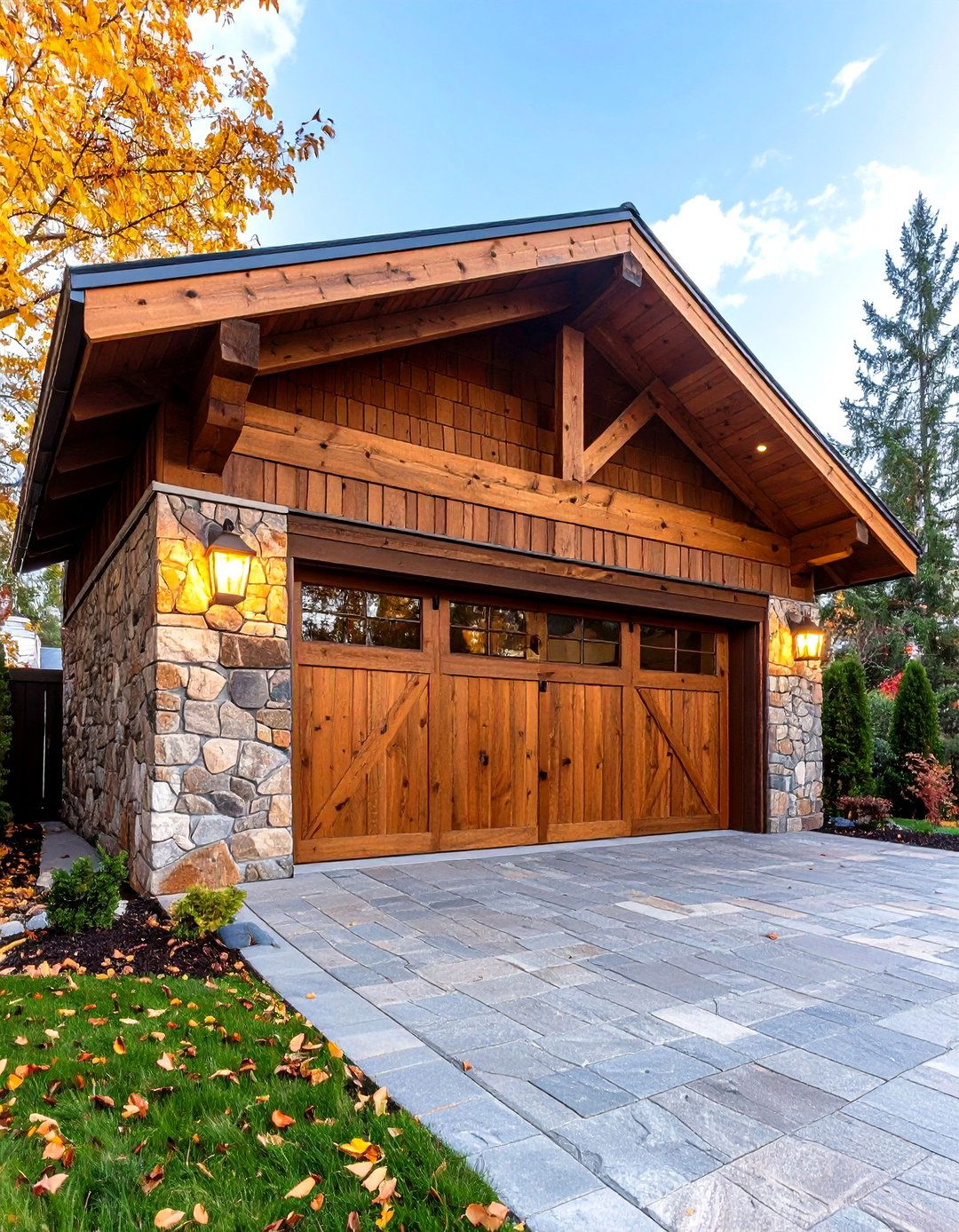
Incorporating a stone accent wall provides a natural focal point in a rustic garage. Use thin stone veneer panels in neutral tones like slate or limestone, adhering them to an underlayment and sealing the surface to guard against moisture. Frame the stone section with reclaimed wood beams for a crafted appearance, and illuminate the corner with adjustable spotlight fixtures. The tactile stone texture offers depth and contrasts beautifully with surrounding wood surfaces. Place a bench or tool rack against this backdrop to create a photo-worthy work zone. This design elevates the rustic garage by blending mineral and timber elements for a balanced, organic look.
14. Potted Greenery to Refresh Rustic Garage Atmosphere
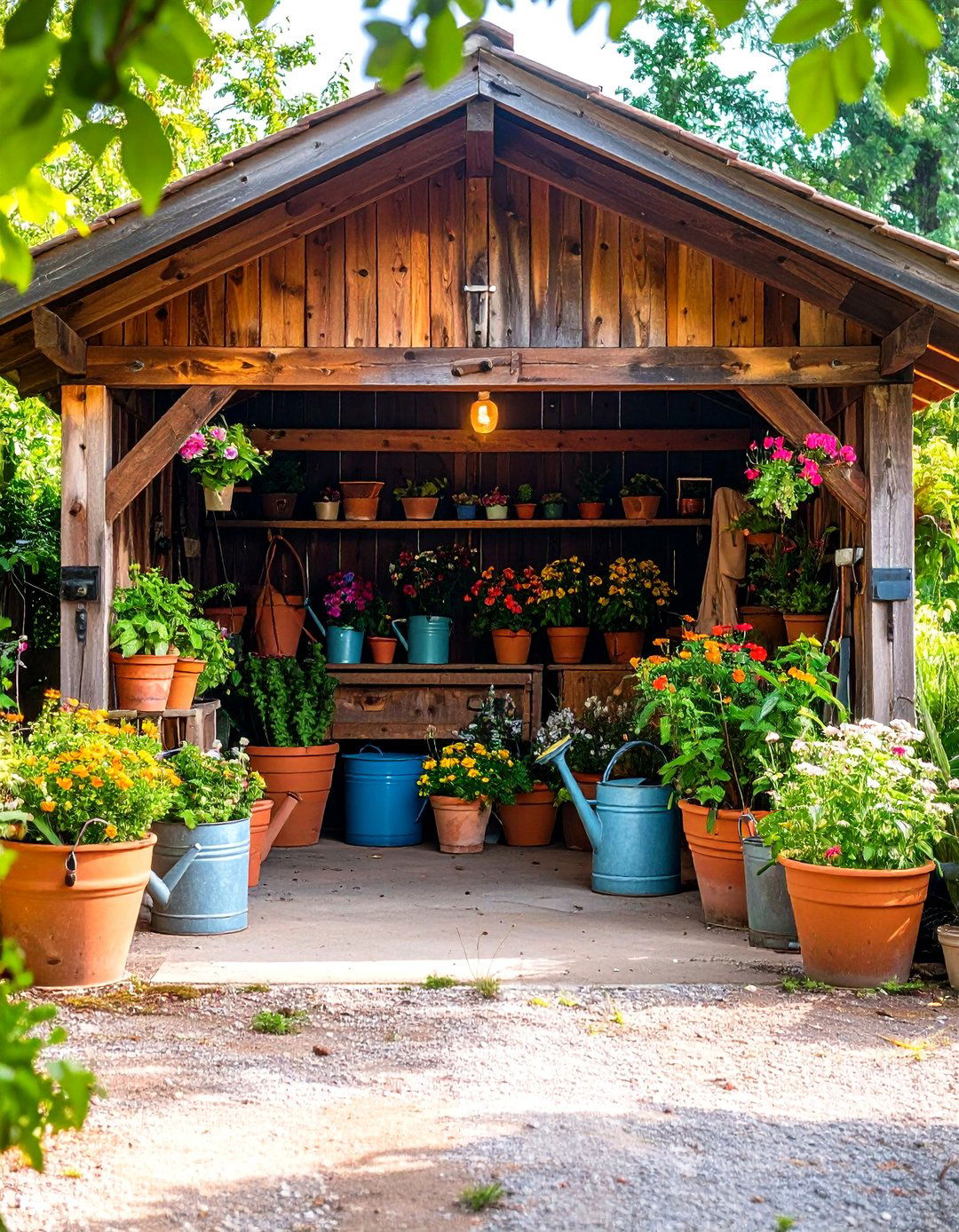
Adding potted plants introduces living color and improves air quality in a rustic garage. Select low-maintenance varieties such as snake plants, pothos, or ZZ plants that thrive in indirect light. Place them in galvanized tubs, terracotta pots, or vintage metal watering cans to reinforce the rustic theme. Position greenery on open shelving, windowsills, or a repurposed wooden crate. For vertical impact, install a floating wooden planter box beneath a lofted area or along a wall. These plants soften industrial materials and invite a breath of fresh air into your workspace. With minimal upkeep, potted greenery transforms the rustic garage into a more inviting environment.
15. Rustic Garage Ceiling Planks to Add Warmth and Depth
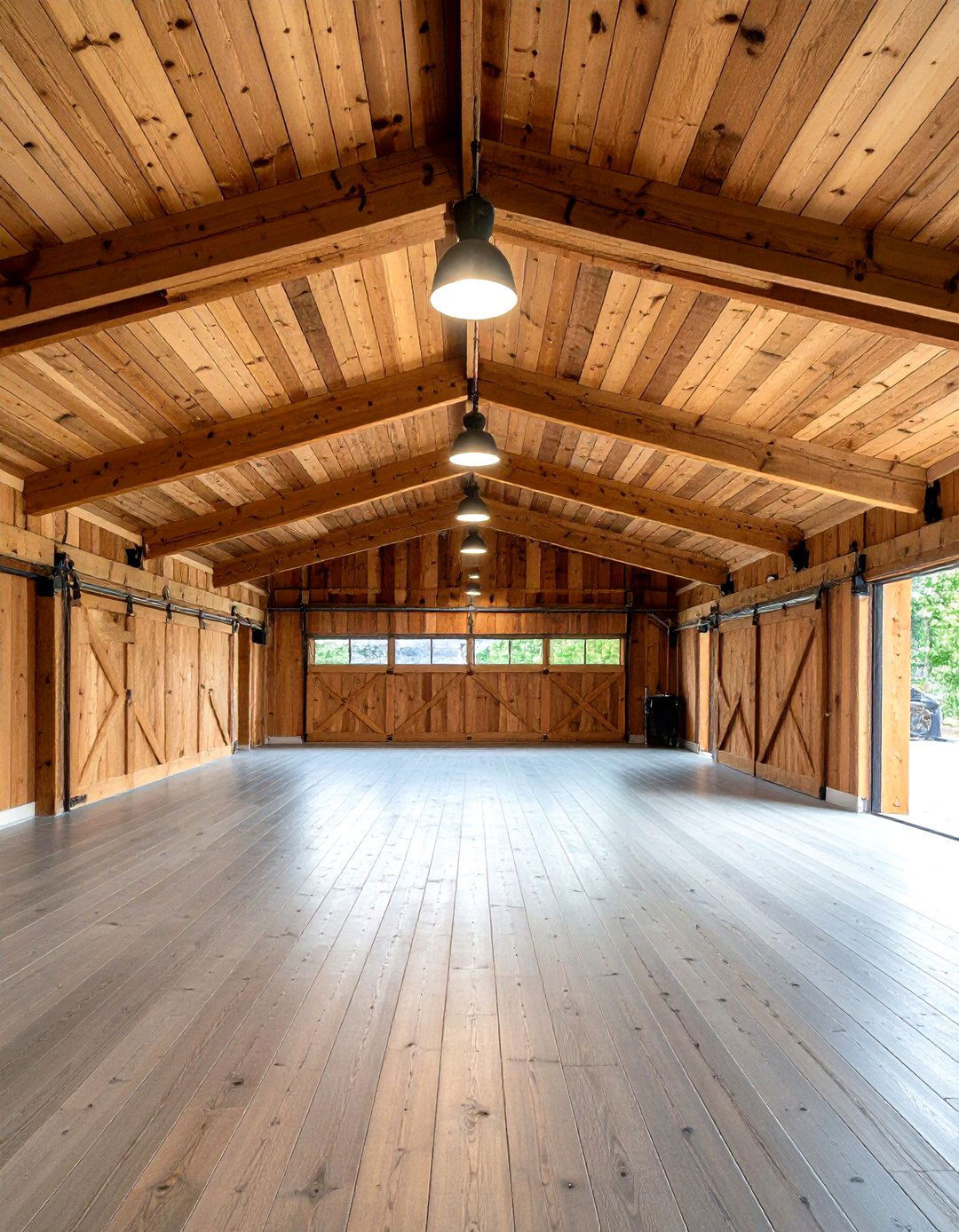
Installing wood planks on the ceiling brings architectural interest and warmth to a rustic garage. Choose tongue-and-groove pine or cedar boards, cutting them to fit securely between joists. Fasten each plank with finish nails, then stain or whitewash to match your color palette. The linear pattern draws the eye upward, making the space feel cozier and more finished. Incorporate recessed lighting fixtures between planks to maintain a clean look. For an exposed-truss effect, alternate plank widths to accentuate the roof’s structural lines. This ceiling treatment balances raw utility with refined craftsmanship, enriching the ambiance of a rustic garage.
16. Antique Hardware Hooks for Rustic Garage Tool Storage
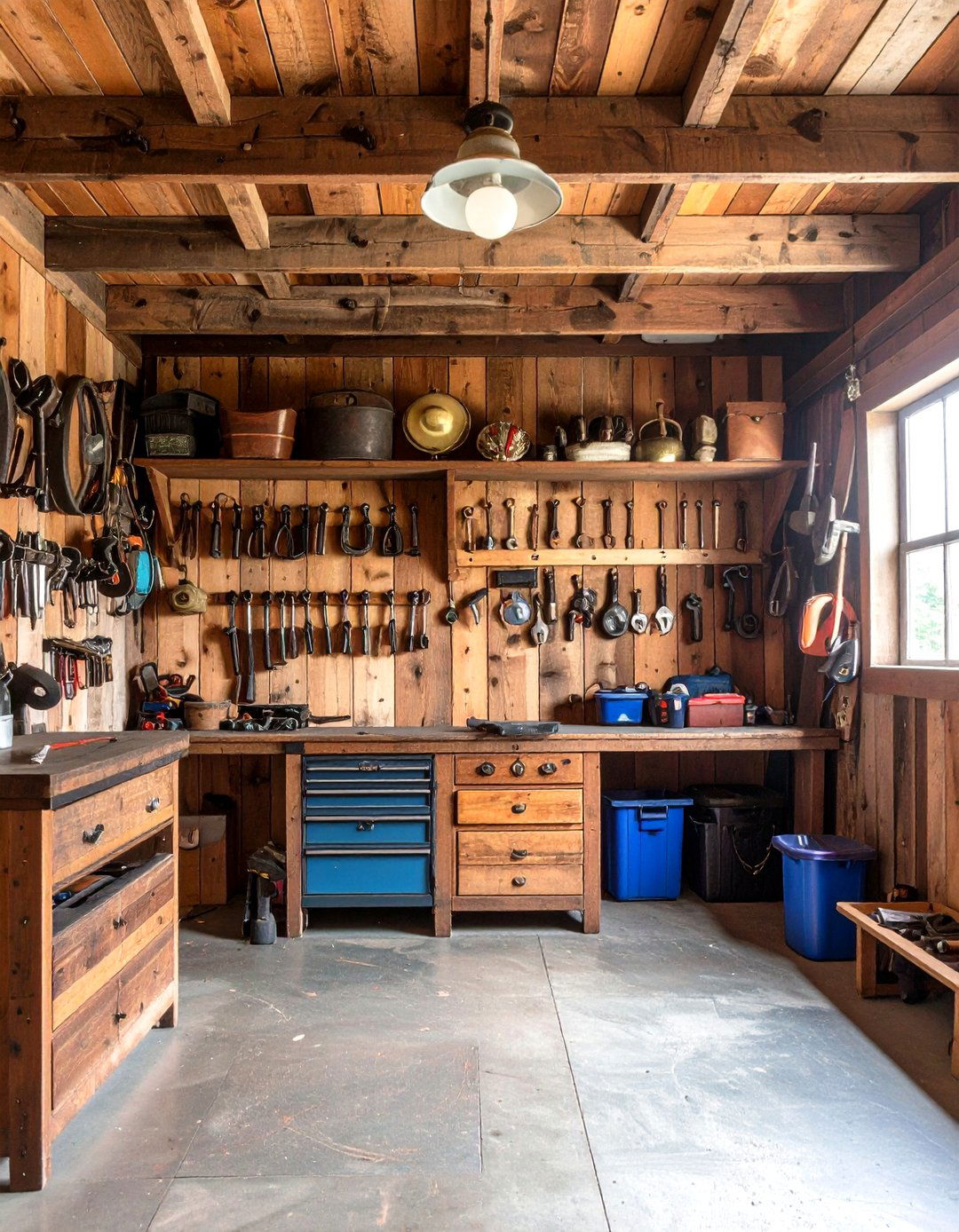
Antique-style hooks provide functional flair when storing tools in a rustic garage. Source cast-iron or brass hooks with ornate detailing from salvage suppliers or vintage markets. Mount them at varied heights on a plank of reclaimed wood running horizontally along one wall. Hang heavy tools, extension cords, and gardening equipment, ensuring the wood plank is anchored into studs for stability. Use matching bolts and hardware to maintain cohesive styling. This hardware display doubles as wall art, celebrating craftsmanship while keeping your workspace tidy. The combination of aged metal and rustic wood planks creates an authentic workshop vibe.
17. Heater Stove for Year-Round Comfort in Rustic Garage
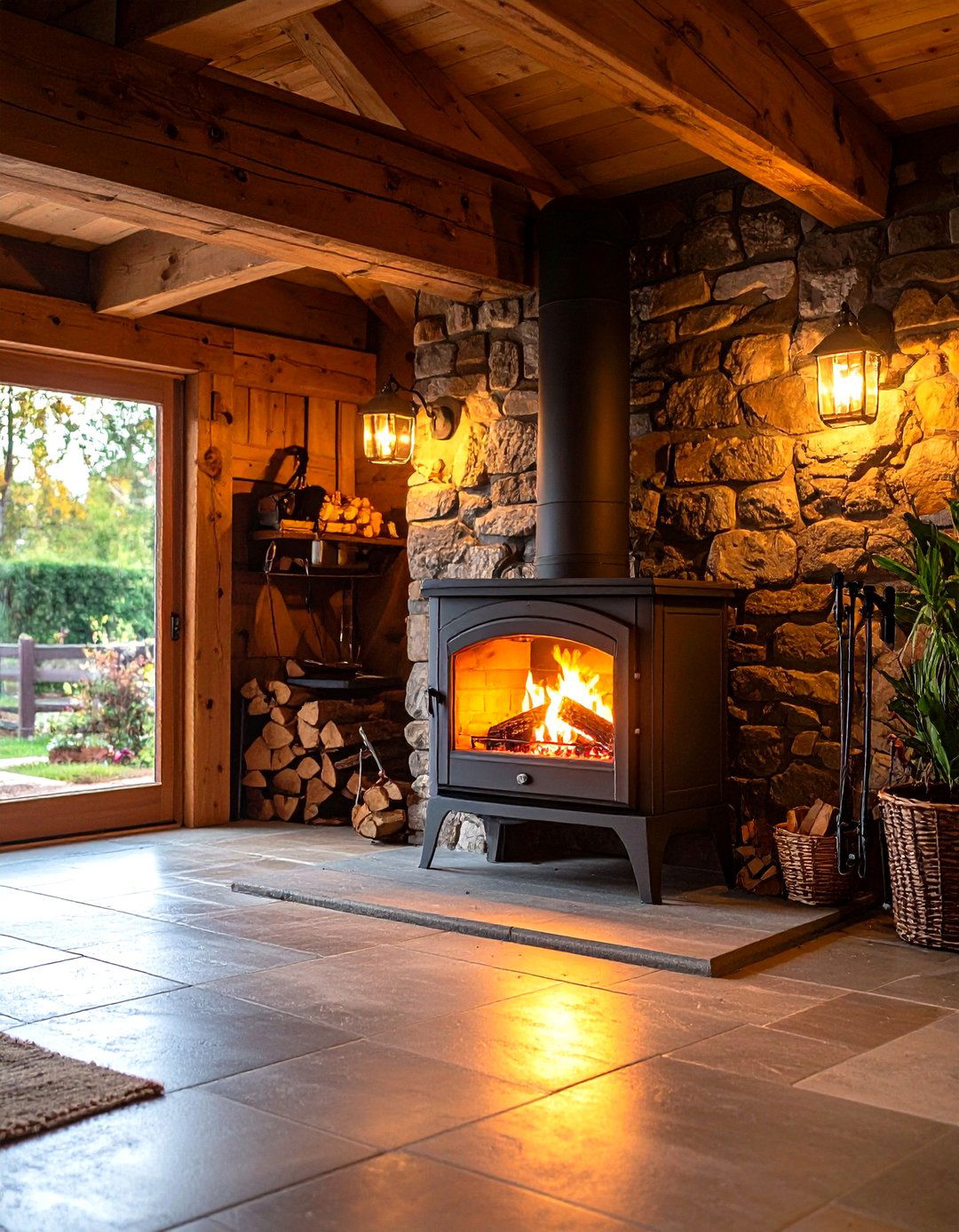
A compact wood-burning or pellet stove transforms your rustic garage into a year-round workspace. Install the stove on a noncombustible pad near an exterior wall, following all local codes and manufacturer guidelines. Use a stainless-steel flue pipe to vent exhaust safely, sealing any gaps with high-temperature silicone. Surround the stove with a stone or tile backdrop to protect the wall and reflect heat. Add a small stack of reclaimed logs in a metal basket for easy refueling. This heating solution not only extends your garage’s usability into colder months but also adds a cozy focal element that complements rustic materials.
18. Overhead Loft for Extra Storage in a Rustic Garage
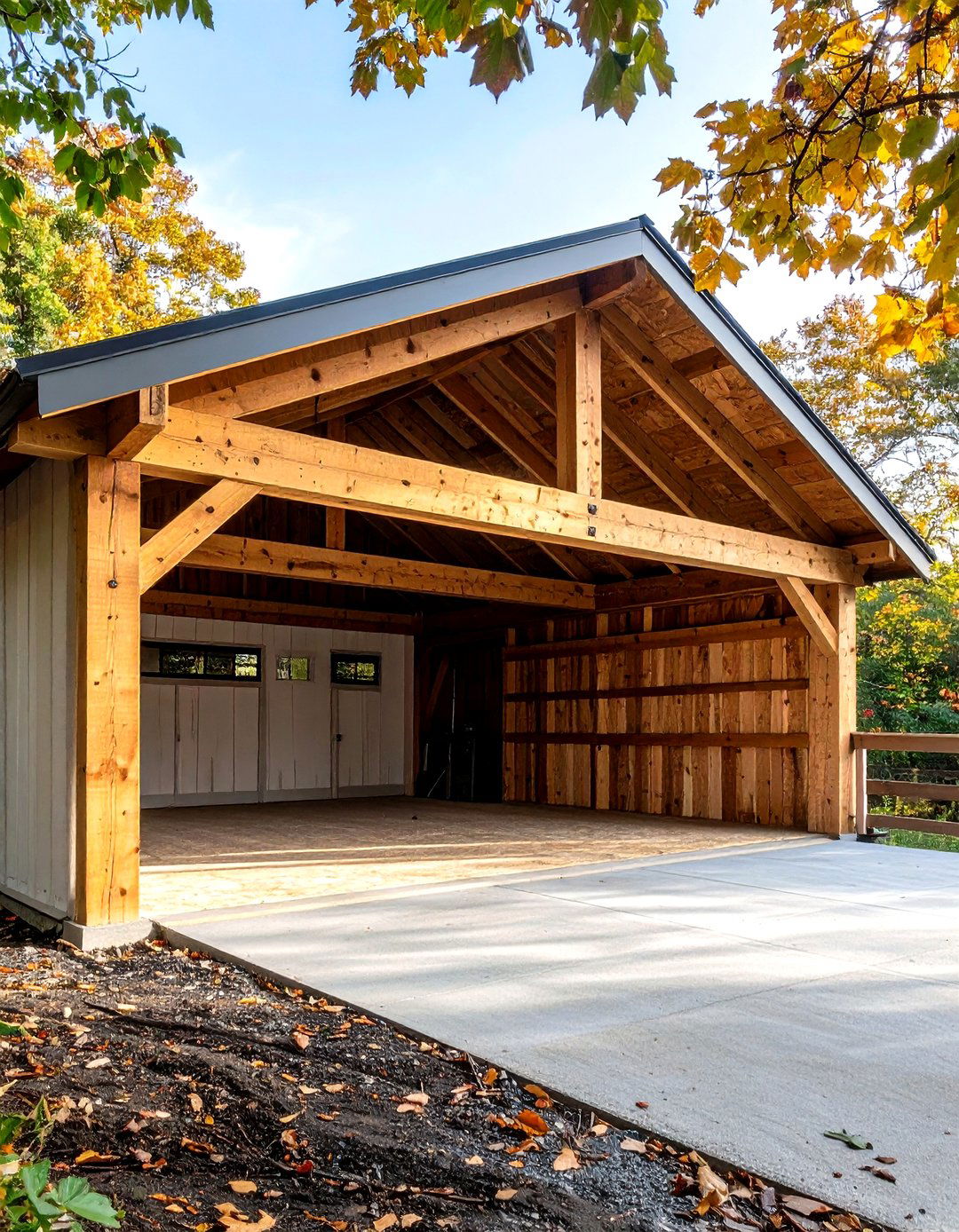
Building an overhead loft maximizes vertical space in a rustic garage without sacrificing floor real estate. Begin by erecting sturdy posts anchored into the concrete floor and ceiling joists, then install thick plywood decking for the loft surface. Frame the perimeter with reclaimed wood beams, adding a simple railing for safety. Use the loft to stash seasonal items, rarely used equipment, or custom storage bins. Install a folding ladder or pulley system for effortless access. Lighting beneath the loft ensures the area below remains bright, while the loft itself benefits from natural or overhead fixtures. Similar to garage conversion best practices, integrating a loft avoids costly offsite storage solutions by optimizing existing overhead space.
19. Mason Jar Storage for Small Parts in Rustic Garage

Repurposing mason jars for small-part storage keeps hardware visible and organized in a rustic garage. Screw the jar lids into a wooden plank mounted on the wall, then twist the jars on to seal. Label each jar with a chalk marker for quick identification of nuts, bolts, and washers. For larger bits, use wide-mouth jars or repurpose metal canisters. The clear glass showcases contents at a glance, while the wood paneling and mason jar combos reinforce the rustic aesthetic. Group jars over the workbench or near frequently used tool stations to streamline project flow. This system turns everyday items into decorative, utilitarian accents.
20. Rustic Garage Rug for Cohesive Aesthetic and Comfort
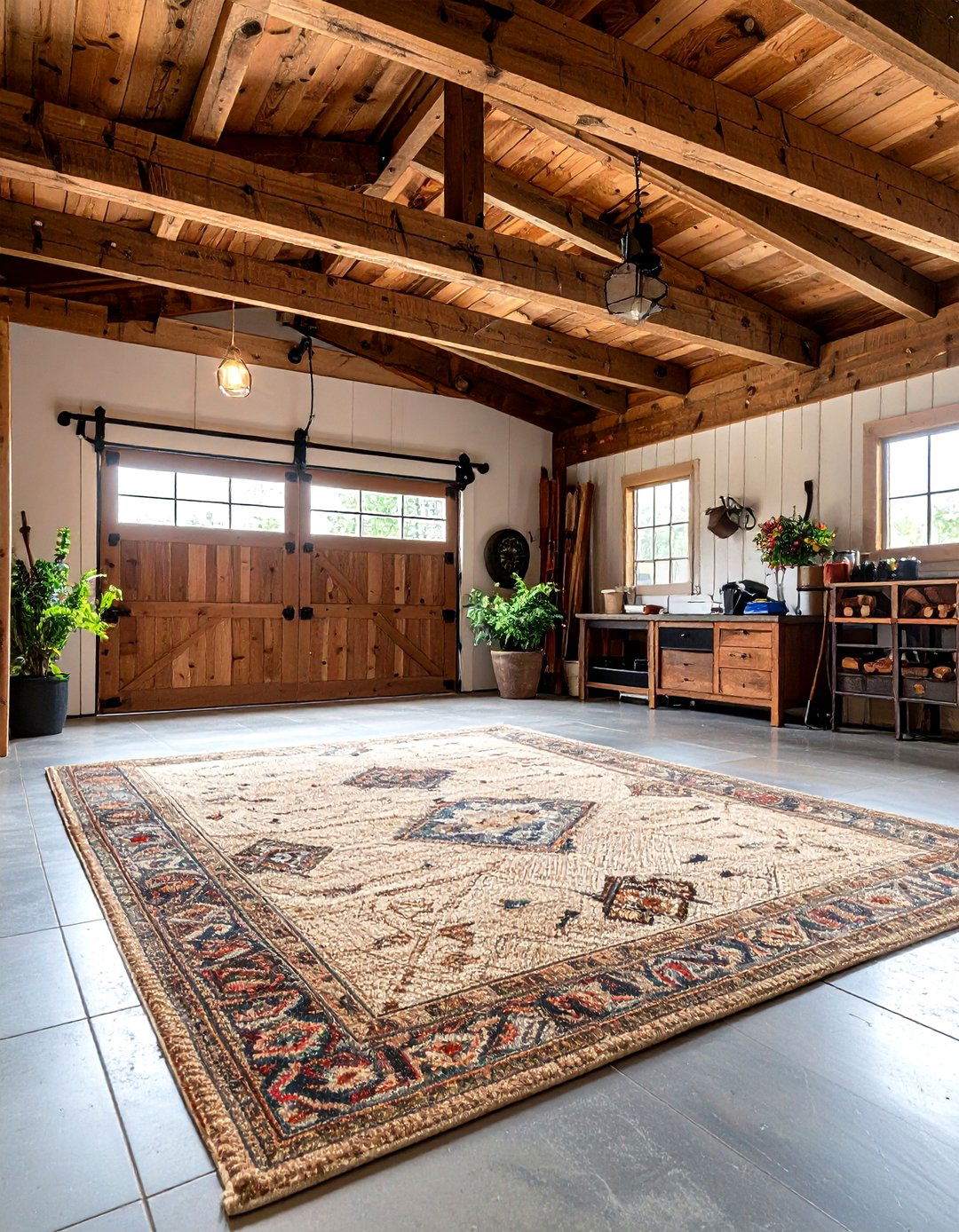
Laying down a rugged area rug can unify seating and workspace zones in a rustic garage. Opt for a low-pile, outdoor-rated rug made from durable materials like polypropylene or jute. Choose a pattern with earthy tones—think muted reds, browns, and greens—to complement wood and metal finishes. Place the rug beneath lounge furniture or in front of the workbench to soften hard surfaces underfoot. The rug’s texture provides traction and catches debris before chairs are moved inside the house. Regular vacuuming and occasional hosing down will keep it looking fresh. This finishing touch adds warmth and clearly defines functional areas in your rustic garage.
Conclusion:
Embracing rustic design elements in your garage transforms it from a purely utilitarian space into a personalized sanctuary that reflects your style and supports your projects. By incorporating materials like reclaimed wood, corrugated metal, and natural stone alongside functional features such as chalkboard walls, mason jar storage, and matte epoxy floors, you’ll achieve a balance of charm and utility. Whether you prioritize storage efficiency, cozy seating, or year-round comfort, these twenty rustic garage ideas offer practical inspiration for any DIY enthusiast. Start with one feature that resonates with you, and watch your garage evolve into a space that’s as inviting as it is efficient.


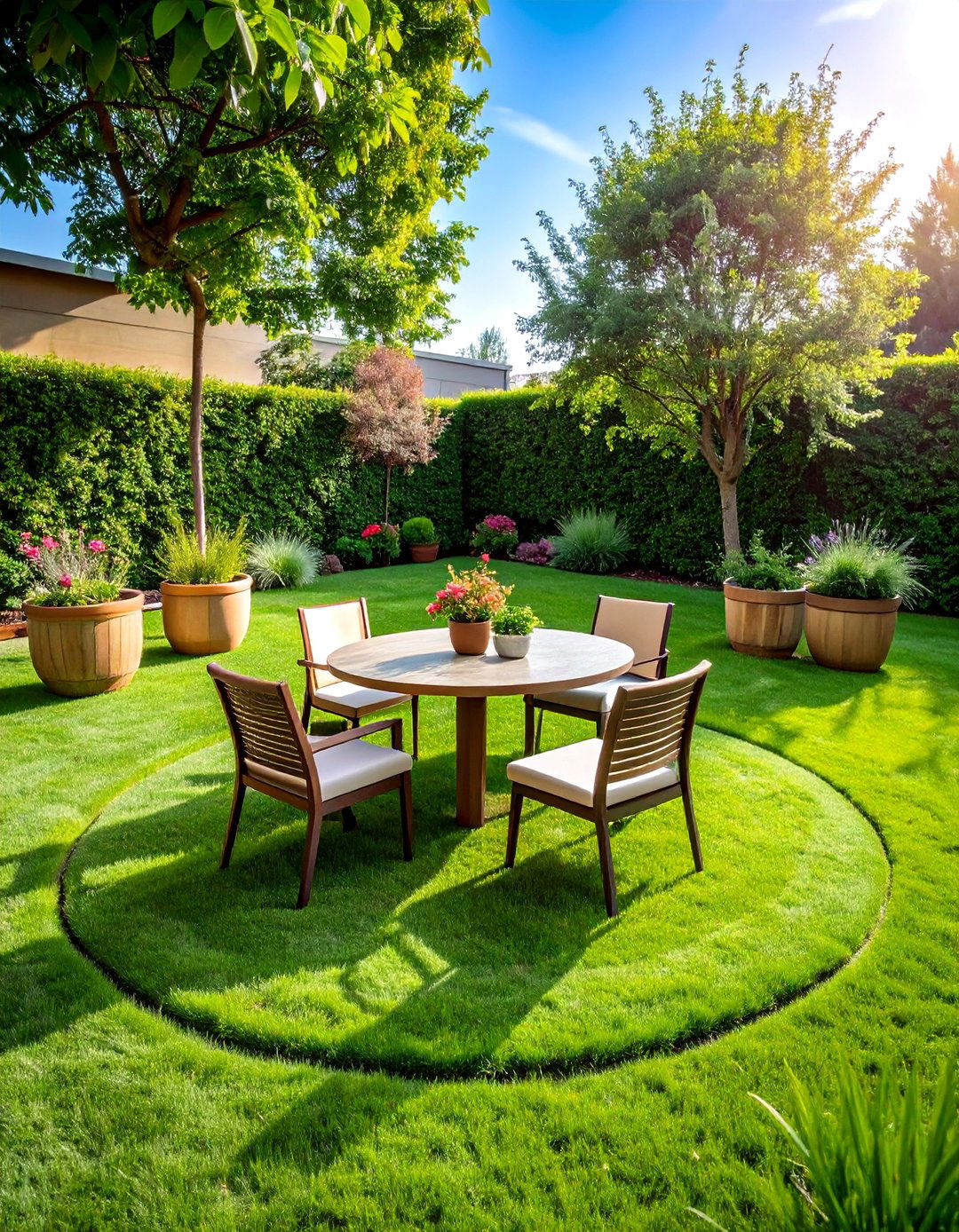

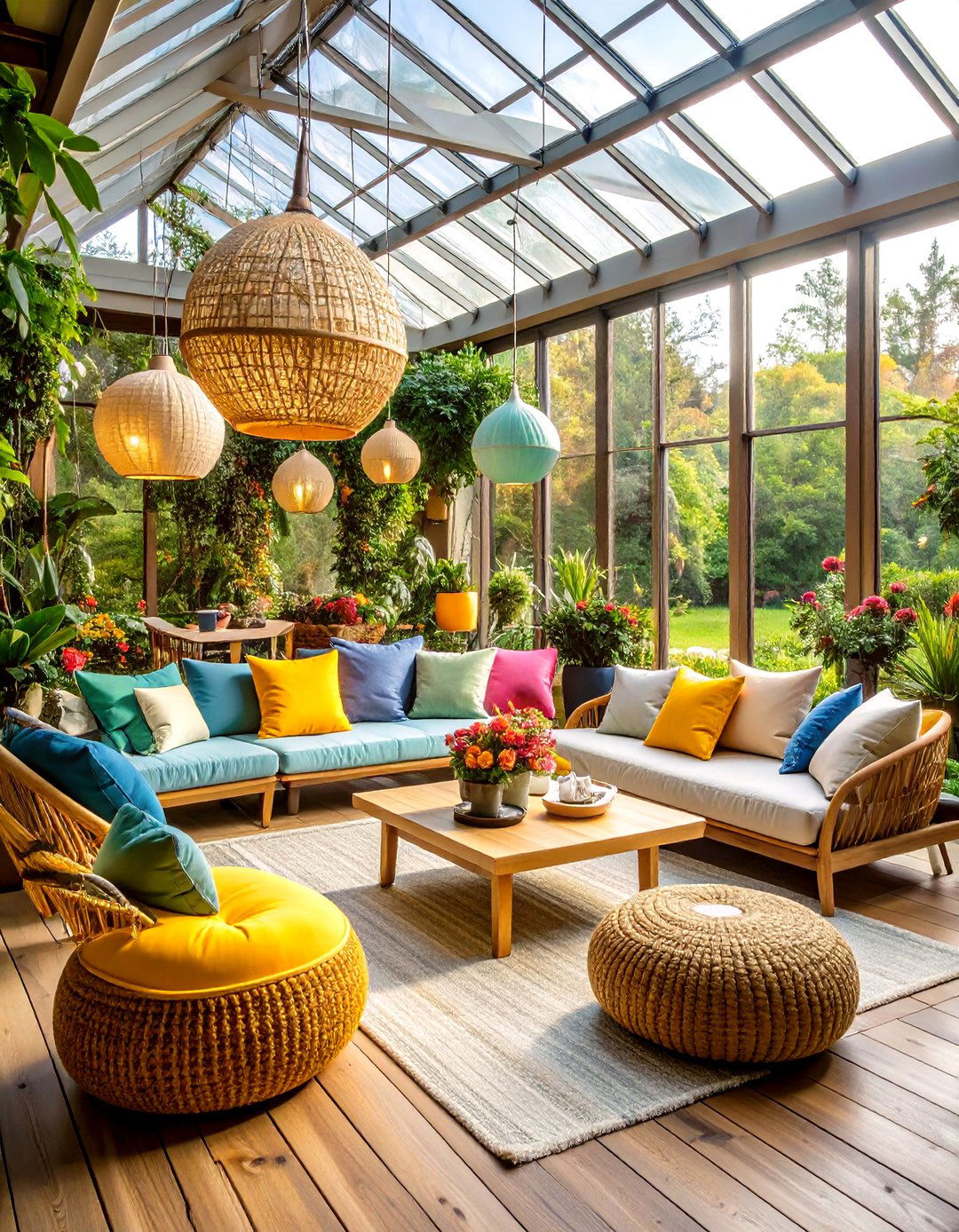
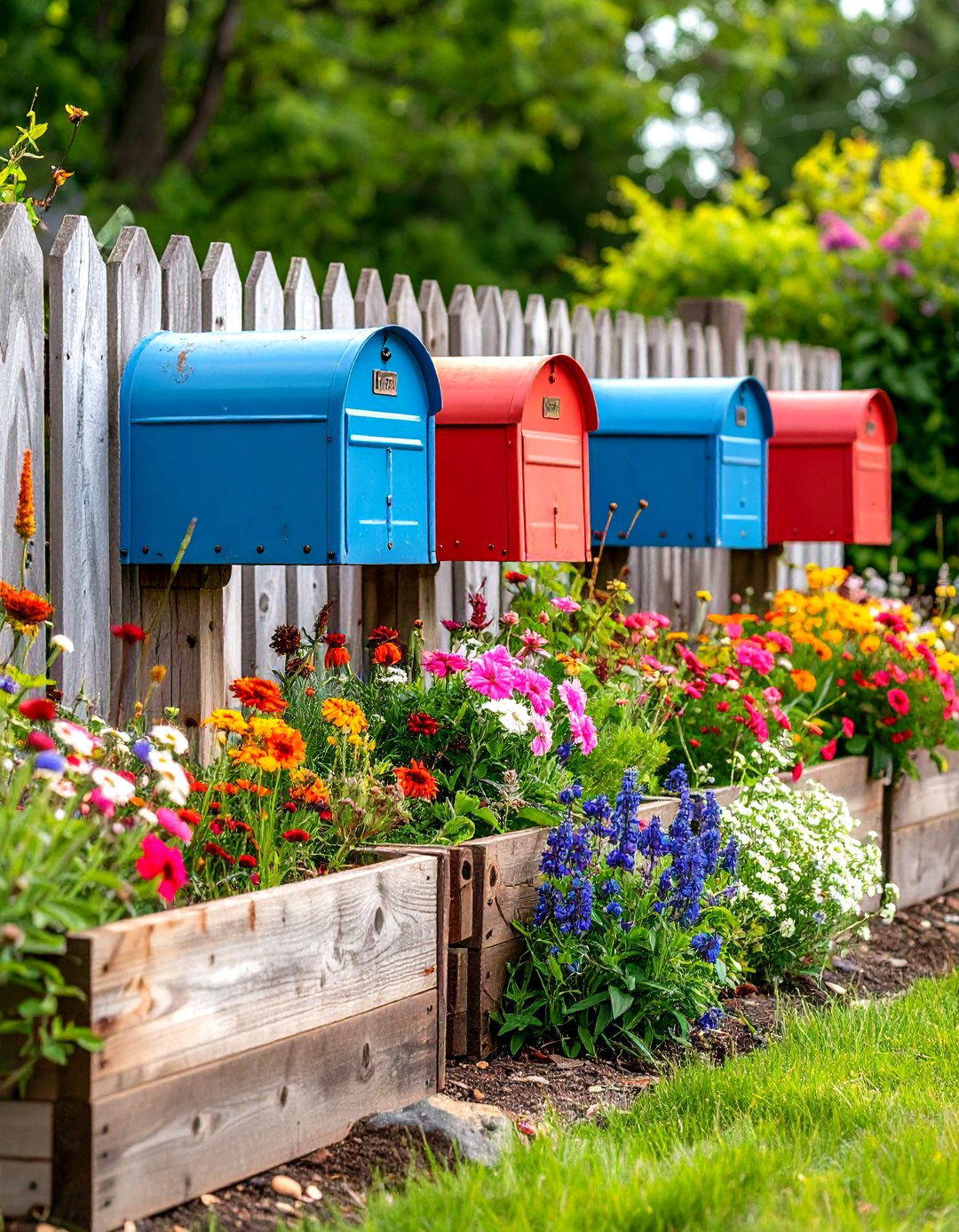
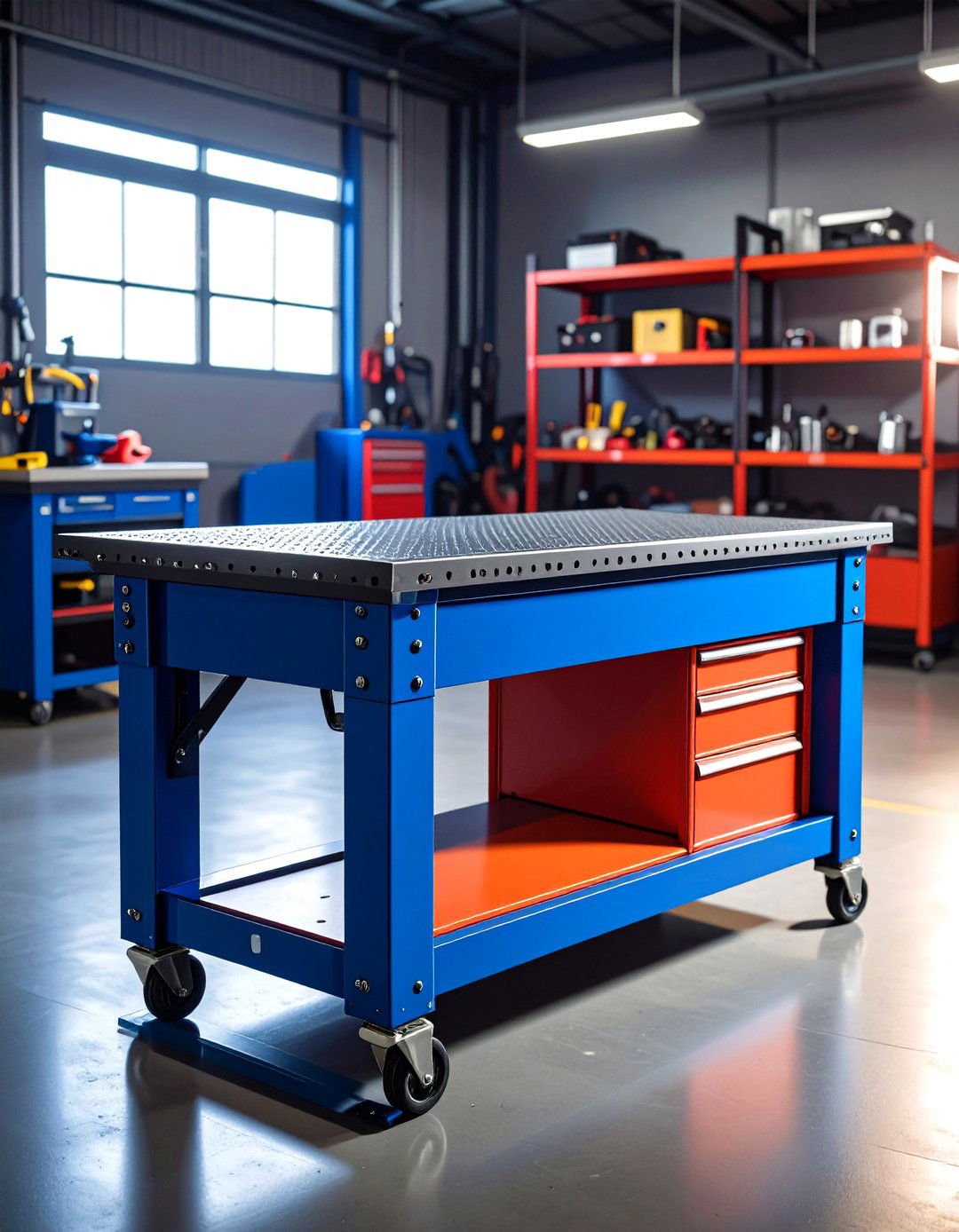
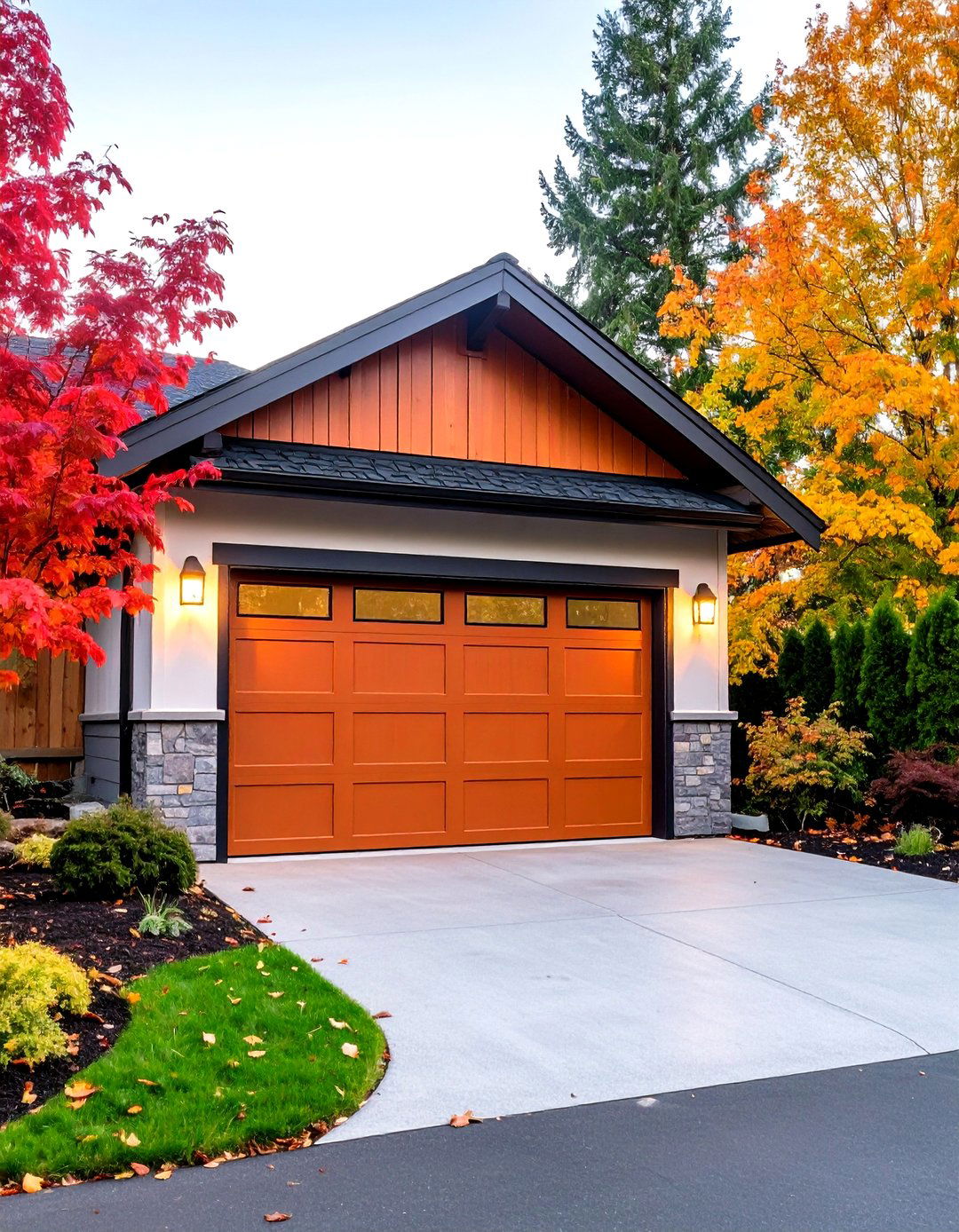
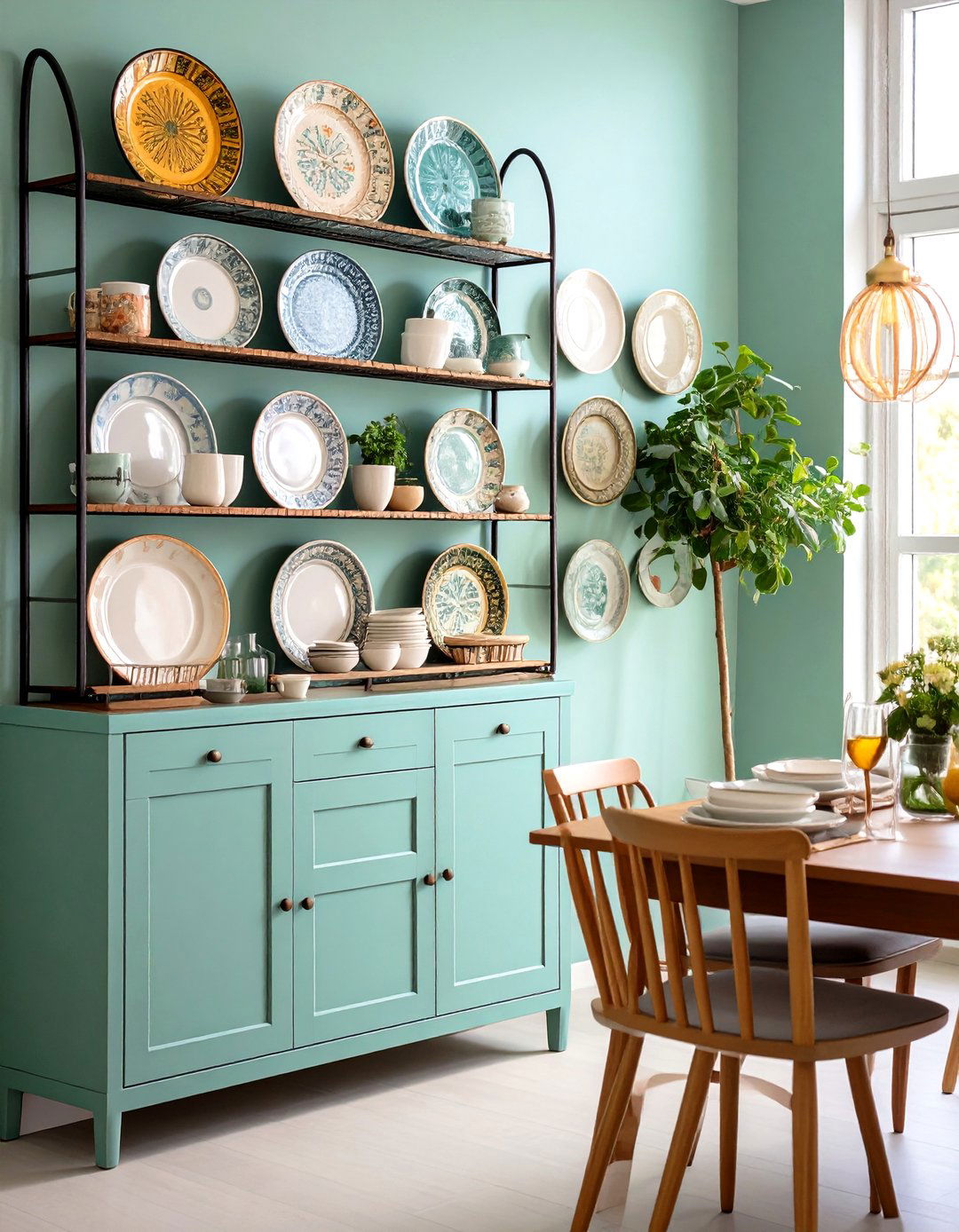






Leave a Reply